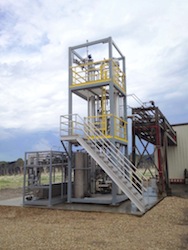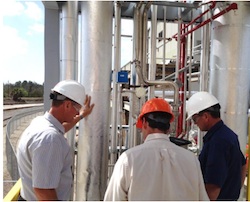On the surface it may seem like the technology for producing ethanol is pretty advanced. But when you talk with Darren Eng, CEO of Greenbelt Resources Corporation, they don’t believe today’s technology is near where it could be so they are continually striving for innovation.
 Unlike the traditional biofuel producers who look at producing 25 million plus gallons per year, and send their ethanol all over the country and in some cases across the wide oceans, Eng says Greenbelt’s strategy is working with local communities to convert their waste to biofuels that are then used locally. And for a small community, a “small-scale,” system can range between 500,000 gallons per year (gpy) up to 2 million gpy. In line with this thinking, under 2 million gpy ethanol modules could soon be the new “big-scale”. In other words, Greenbelt’s technology is the perfect example of “community energy,” or locally owned energy projects, and they can produce modules from 100,000 to 2 million gpy.
Unlike the traditional biofuel producers who look at producing 25 million plus gallons per year, and send their ethanol all over the country and in some cases across the wide oceans, Eng says Greenbelt’s strategy is working with local communities to convert their waste to biofuels that are then used locally. And for a small community, a “small-scale,” system can range between 500,000 gallons per year (gpy) up to 2 million gpy. In line with this thinking, under 2 million gpy ethanol modules could soon be the new “big-scale”. In other words, Greenbelt’s technology is the perfect example of “community energy,” or locally owned energy projects, and they can produce modules from 100,000 to 2 million gpy.
“Our model is for our technology to be used to locally recycle (or process) locally generated feedstocks (ideally waste materials) into products that can be consumed locally,” said Eng. Greenbelt’s target feedstock is waste material and their suite of products include ethanol, filtered water and fertilizer. “So our target market,” continued Eng, “is anyone generating an appropriate feedstock at quantities too small to make it worth transporting long distances but large enough to take advantage of one of our systems.”
Eng explained that their technology can use a wide range of feedstocks to produce cellulosic ethanol and byproducts. Feedstock types include wastes from the ag and food industries; waste beverages and beverage bottling process waste; corn harvested for local dairy cow consumption; non-food alternative energy crop growers; island communities; and developing countries. In addition, he said farming consortiums in remote areas who can aggregate their wastes and/or low value crops and convert them into products they would otherwise have to pay high prices for due to the high cost of transportation because of their remoteness, is also a great target for their technology.
The Greenbelt technology is different than large-scale technologies in several ways. The company provides a commercially viable, small scale, modular, energy efficient feedstock-to-product ethanol production system. The overall system is semi-automated with their distillation and dehydration modules fully automated, explained Eng. “The front-end (typically fermentation) module only requires a minimal amount of manual labor each day for feedstock input. Additionally, the load out of products requires some oversight if not manual handling in some instances,” he added.
A key component to the system’s uniqueness and its high efficiency is the inclusion of a patent pending membrane dehydration module. Greenbelt is the only biofuel company that offers membrane technology. “Membrane use allows for a less complicated system design and requires about a third less energy compared to a molecular-sieve as a result of the complexity,” said Eng.
There is also a slight but simple difference in how it works. The membrane has a single, low energy pump drawing a strong but low flow vacuum. Whereas molecular-sieve technology not only has a pump pushing the hydrous ethanol over the desiccant beads, it also requires a second parallel setup for use when the other molecular sieve is being recharged. “Plus the recharge requires both heat in the form of steam and more pumps both pushing in the steam and one drawing a strong high flow vacuum to draw the water out of the desiccant beads,” said Eng. “We have also incorporated predominantly air cooling vs water cooling, further reducing energy consumption.”
I asked Eng how long it takes to install the technology or better yet, when will the technology begin producing ethanol from point of purchase? Traditional, large-scale plants take a minimum of 18 months to construct not including the time it takes for permitting (this could take up two plus years).
 Eng said depending on the size of the system requested and barring any excessive local permitting issues, they can design, manufacture and deliver a system in as little as five months, with larger systems taking about eight to ten months to deliver and install. This assumes, said Eng, simultaneous assembly of the distillation and dehydration modules in their Paso Robles, California facility while the client’s site is prepared with front-end tanks and piping installed and corresponding site prep in the areas where the D&D modules are to be installed.
Eng said depending on the size of the system requested and barring any excessive local permitting issues, they can design, manufacture and deliver a system in as little as five months, with larger systems taking about eight to ten months to deliver and install. This assumes, said Eng, simultaneous assembly of the distillation and dehydration modules in their Paso Robles, California facility while the client’s site is prepared with front-end tanks and piping installed and corresponding site prep in the areas where the D&D modules are to be installed.
A question everyone wants to know before taking the investment plunge is what is the return on my investment (ROI)? “The ROI of each system is greatly dependent on the specific characteristics of each installation but in general from an operating standpoint cost to produce each gallon of ethanol is roughly under a dollar,” Eng answered. “Ideally, processing (or recycling) of the system feedstock will eliminate some costs associated with the feedstock such that there is either a cost savings to the generator, or a revenue stream in the form of a tipping fee for the system to take in the feedstock. Payback depends on the size of the system and can range from two years to six years.”
Eng said Greenbelt is focused on what is important to their customers: helping them balance good business decisions with being socially responsible. “Greenbelt solutions are designed to make good business sense. Moreover, our technology is high quality workmanship, energy efficient and as easy to use with 24/7 technical support and monitoring and remote control services available. And we focus on minimizing the onsite labor and skill level needed to operate the system,” said Eng.
He noted that a customer doesn’t have to purchase their entire system: their modular D&D systems are available for purchase separately. For example, said Eng, a university or an advanced biofuel technology company with a bench-scale cellulosic solution could purchase one of their systems for the back-end of their pilot plant, or even a small scale commercially viable setup.
“Also, our proprietary membrane dehydration module dramatically reduces the energy required to dehydrate ethanol even with a 180 proof feed coming from the distillation module.” Eng concluded, “Greenbelt will continue to expand the versatility and efficiency of the membrane module.”
As more and more communities begin to adopt the community energy model, Greenbelt will be poised as a viable component of the total energy solution.

